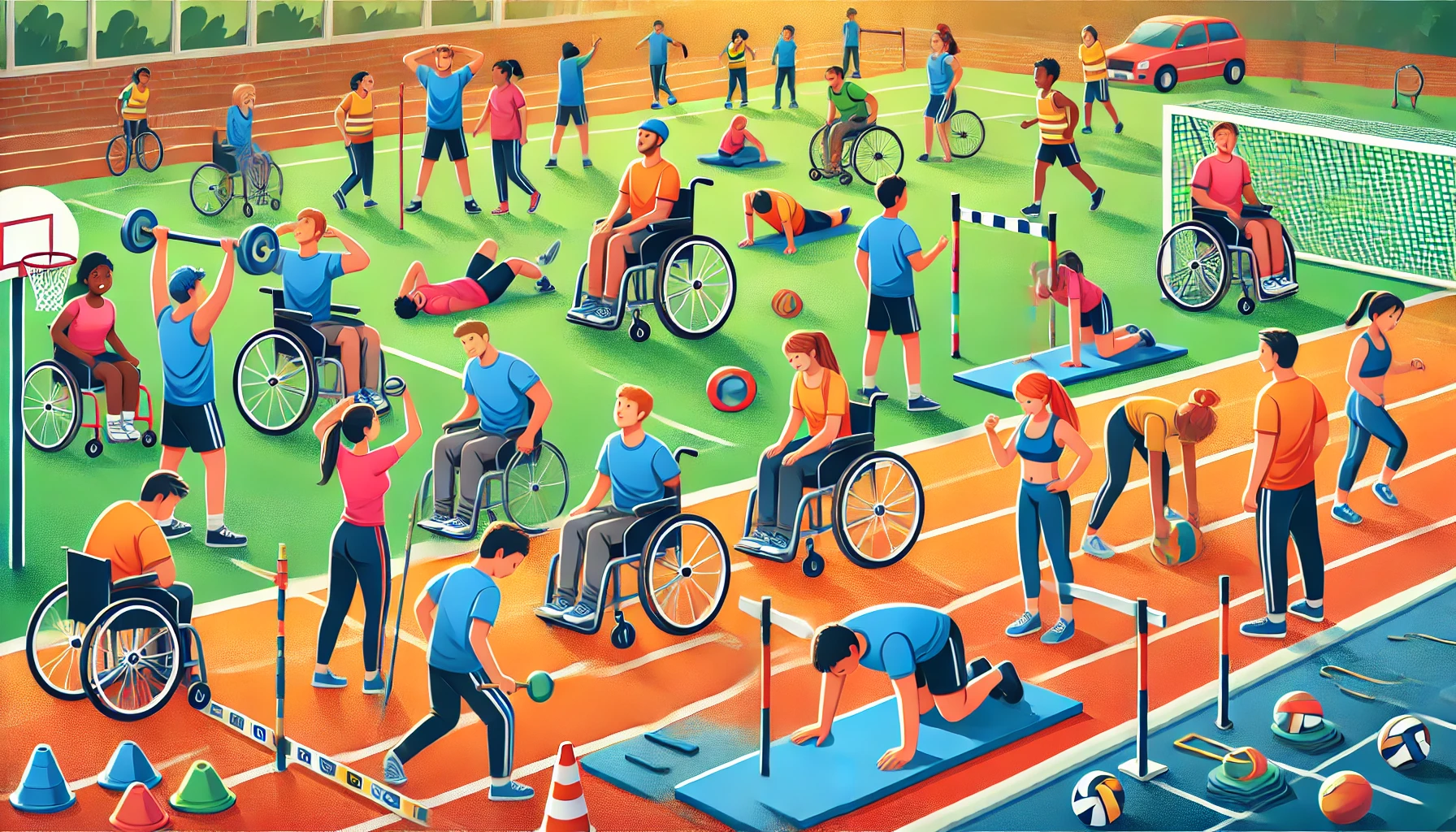Introduction
The Brockport Physical Fitness Test (BPFT) is a specialized fitness assessment protocol designed to meet the needs of students with disabilities. Developed from the Project Target study funded by the U.S. Department of Education in 1993, the BPFT offers a criterion-referenced approach to evaluating the physical fitness of youngsters aged 10 to 17, including those with various disabilities. This guide will cover the history, target group, test items, equipment required, and administration procedures for the BPFT.
History: Project Target
In 1993, the U.S. Department of Education funded Project Target, a study aimed at developing a health-related and criterion-referenced physical fitness test protocol for youngsters with disabilities. This research was primarily conducted at the State University of New York, College at Brockport, leading to the creation of the Brockport Physical Fitness Test. The study involved testing 1,542 youngsters with and without disabilities to develop a comprehensive fitness assessment tool suitable for a wide range of physical abilities.
Brockport Physical Fitness Test (BPFT) – Target Group
The Brockport Physical Fitness Test is designed for and is suitable for use with both able-bodied youngsters and those with disabilities such as:
- Intellectual disabilities
- Spinal cord injuries
- Cerebral palsy
- Visual impairments
- Congenital anomalies
- Amputations
Tests
The BPFT includes 27 test items, offering a mix of traditional fitness tests and tests specifically modified for youngsters with disabilities. The test battery can be customized for nearly any student, typically involving only four to six test items per individual. The following sections provide detailed descriptions of the various test items, categorized by fitness component.
Musculoskeletal Functioning, Muscular Strength, and Endurance
Trunk Lift
Aim
To measure the strength and flexibility of the lower back muscles.
Equipment Required
- Gym mat
- Ruler or measuring tape
Administration
- The student lies face down on the mat with hands placed under the thighs.
- The student lifts the upper body off the ground as high as possible, keeping the head in line with the spine.
- Measure the distance from the floor to the chin in centimeters.
Scoring
- Record the distance lifted in centimeters.
- The higher the lift, the better the strength and flexibility of the lower back.
Grip Strength
Aim
To measure hand and arm strength.
Equipment Required
- Grip dynamometer
Administration
- The student holds the dynamometer in the dominant hand.
- Squeeze the dynamometer with as much force as possible.
- Record the reading from the dynamometer in kilograms or pounds.
Scoring
- The higher the reading, the better the hand and arm strength.
Bench Press
Aim
To measure upper body strength and endurance.
Equipment Required
- 35lb (15.9kg) barbell
Administration
- The student lies on a bench with the barbell positioned above the chest.
- Perform as many bench presses as possible with proper form.
Scoring
- Record the number of correctly completed bench presses.
Isometric Push-Up
Aim
To measure upper body strength and endurance.
Equipment Required
- Flat, clean surface or gym mat
Administration
- The student holds a raised push-up position for up to 40 seconds.
Scoring
- Record the duration the position is held, up to 40 seconds.
Push-Up
Aim
To measure upper body strength and endurance.
Equipment Required
- Flat, clean surface or gym mat
Administration
- The student performs as many push-ups as possible at a rate of one push-up every three seconds.
Scoring
- Record the number of correctly completed push-ups.
Seated Push-Up
Aim
To measure upper body strength.
Equipment Required
- Chair
Administration
- The student extends the arms and raises the body out of the chair, holding this position for as long as possible.
Scoring
- Record the duration the position is held.
Dumbbell Press
Aim
To measure upper body strength and endurance.
Equipment Required
- 15lb (6.8kg) dumbbell
Administration
- The student lifts the dumbbell as many times as possible at a specific cadence while sitting in a chair.
Scoring
- Record the number of repetitions completed.
Reverse Curl
Aim
To measure hand, wrist, and arm strength.
Equipment Required
- 1lb (0.5kg) dumbbell
Administration
- The student sits in a chair and performs one repetition of bringing the dumbbell from the thigh to the flexed-arm position, holding it for two seconds, then returning it to the thigh in a controlled manner.
Scoring
- Record the successful completion of the repetition.
Push/Walk (40m)
Aim
To measure mobility and cardiovascular endurance.
Equipment Required
- Measuring tape
- Cones or markers
Administration
- The student walks or pushes a wheelchair at a comfortable speed for 40 meters, with a 5-meter start zone.
Scoring
- Record the time taken to cover the 40-meter distance and ensure the heart rate stays below 120 bpm (walkers) or 114 bpm (wheelchair users).
Wheelchair Ramp Test
Aim
To measure upper-body strength and endurance.
Equipment Required
- Standard wheelchair ramp
Administration
- The student attempts to push their wheelchair up a ramp that is at least 8 feet (2.4 meters) long with an 8.3% gradient.
Scoring
- Record the successful completion of the ramp ascent.
Curl-Up
Aim
To measure abdominal strength and endurance.
Equipment Required
- Flat, clean surface
Administration
- The student performs up to 75 curl-ups at a rate of one every three seconds.
Scoring
- Record the number of correctly completed curl-ups.
Curl-Up (Modified)
Aim
To measure abdominal strength and endurance.
Equipment Required
- Flat, clean surface
Administration
- The student performs curl-ups with hands resting on the thighs, completing as many as possible.
Scoring
- Record the number of correctly completed curl-ups.
Extended-Arm Hang
Aim
To measure upper body strength and endurance.
Equipment Required
- Overhead bar
Administration
- The student hangs from the bar with straight arms for up to 40 seconds.
Scoring
- Record the duration of the hang.
Flexed-Arm Hang
Aim
To measure upper body strength and endurance.
Equipment Required
- Overhead bar
Administration
- The student hangs with the chin above the bar, timing how long they can maintain this position.
Scoring
- Record the duration of the hang.
Pull-Up
Aim
To measure upper body strength and endurance.
Equipment Required
- Overhead bar
Administration
- The student performs pull-ups, pulling the body up so the chin rises above the bar, then returning to the fully extended position.
Scoring
- Record the number of correctly completed pull-ups.
Pull-Up (Modified)
Aim
To measure upper body strength and endurance.
Equipment Required
- Bar set at a reachable height
Administration
- The student performs pull-ups with the body horizontal, pulling towards the bar.
Scoring
- Record the number of correctly completed pull-ups.
Body Composition
Skinfold Measures
Aim
To estimate body fat percentage.
Equipment Required
- Skinfold calipers
Administration
- Measure skinfold thickness at specific sites (triceps, subscapular, calf).
- Use calipers to pinch and measure the thickness of the skinfold.
Scoring
- Calculate the body fat percentage using standardized equations.
Body Mass Index
Aim
To measure body composition.
Equipment Required
- Weighing scale
- Stadiometer or measuring tape
Administration
- Measure the student’s height and weight accurately.
Scoring
- Calculate BMI using the formula: BMI = Weight (kg) / (Height (m) x Height (m)).
Bioelectrical Impedance Analysis
Aim
To estimate body fat percentage.
Equipment Required
- Bioelectrical impedance analyzer
Administration
- Measure the resistance of body tissues to a small electrical signal.
Scoring
- Calculate the body fat percentage from the resistance measurement.
Aerobic Functioning
PACER Test (20m or 15m)
Aim
To measure aerobic capacity and endurance.
Equipment Required
- Flat, non-slip surface
- Cones or markers
- Audio recording with beeps
Administration
- Mark a distance of 20 or 15 meters on a flat surface.
- Play the audio recording with beeps to signal the start and intervals.
- The student runs back and forth, reaching the opposite end before the beep sounds.
Scoring
- Record the number of laps completed.
Target Aerobic Movement Test
Aim
To assess the ability to sustain moderate-intensity physical activity.
Equipment Required
- Heart rate monitor
Administration
- The student maintains a heart rate between 70 and 85 percent of maximal predicted heart rate for 15 minutes.
Scoring
- Record the duration the target heart rate is maintained.
One-Mile Run/Walk
Aim
To assess aerobic capacity and endurance.
Equipment Required
- Measuring tape or marked track
- Stopwatch
- Cones or markers
Administration
- The student runs or walks a one-mile distance as quickly as possible.
Scoring
- Record the time taken to complete the one-mile run/walk.
Flexibility
Back-Saver Sit & Reach
Aim
To measure the flexibility of the left and right legs separately.
Equipment Required
- Sit and reach box or measuring tape
Administration
- The student performs the sit and reach test with one leg bent.
Scoring
- Record the distance reached for each leg separately.
Shoulder Stretch
Aim
To measure shoulder flexibility.
Equipment Required
- None
Administration
- The student attempts to touch the fingertips together behind the back by reaching over the shoulder and down the back with one arm and across the back with the other arm.
Scoring
- Record whether the fingertips touch.
Apley Scratch Test (Modified)
Aim
To measure shoulder flexibility.
Equipment Required
- None
Administration
- The student attempts to reach overhead with one hand and touch the top of the opposite shoulder blade.
Scoring
- Record whether the student can touch the shoulder blade.
Thomas Test (Modified)
Aim
To measure hip flexibility.
Equipment Required
- Bench
Administration
- The student sits at the edge of a bench, then rolls back onto the bench while pulling both knees to the chest.
Scoring
- Assess hip flexibility based on the ability to maintain the position.
Equipment Required
The BPFT requires only a few relatively inexpensive materials, such as:
- Stopwatch
- Ruler
- Grip dynamometer
- 35lb. barbell
- Seated push-up blocks
- 1lb. weight
- Ramp
- Curl-up strip
- Pull-up bars
- Skinfold caliper
- Height-weight scale
- Sit and reach apparatus
- Heart-rate monitor
- 15lb. dumbbell
- Calibrated tapes (provided with the test kit)
Conclusion
The Brockport Physical Fitness Test provides a comprehensive and flexible tool for assessing the physical fitness of students with disabilities. By understanding and implementing the detailed guidelines for each test, educators can ensure accurate administration and effective training strategies. Regular assessments and structured training programs will help students improve their fitness levels and maintain a healthy lifestyle.
This holistic approach not only promotes physical health but also fosters a culture of fitness and well-being in schools. The Brockport Physical Fitness Test provides valuable insights into the fitness levels of students with disabilities, helping educators and parents develop personalized fitness plans that support the overall development of each student.





